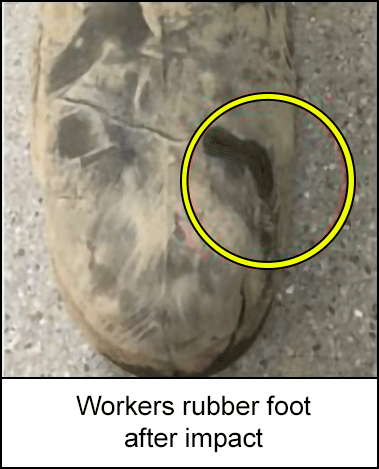-
What happened?
A worker excavating frozen soil using a seven-foot straight tip wand, received a surface laceration and minor burn to the top of the foot.
The worker’s right foot became stuck in mud, causing the worker to stumble and move the wand on top of his foot. The high-pressure water cut the boot above the protective steel toe.

-
Why did it happen?
Cause: The worker was wearing rubber steel toe boots that did not provide adequate protection from the hot, high pressure water (650C at 2000 PSI).
Contributing factors: The wand was not equipped with a handle for proper hand placement and did not have a shut-off valve.

-
What did they learn?
- Communicate to hydro-vac contractors the need for metatarsal foot protection when using a straight tip wand.
- Hydro-vac contractors should use wands with handles that provide adequate grip and a method to stop the flow of water at the wand.
- Owners, prime contractors and employers should assess each scope of work for its specific hazards; ensure proper communication to the work force when changing conditions require specialized personal protective equipment.

-
Ask yourself or your crew
- How can something like this happen here (e.g. on our site)?
- What safety measures (i.e. procedures, controls/barriers) do we have in place to mitigate the risk?
- How do we know the risk controls/barriers are working?
- What improvements or changes should we make to the procedures, controls/barriers or the way we work?

Add to homescreen
If you want to add this app to home screen tap and then ‘Add to Home Screen’.
Content name
Select existing category:
Content name
New collection
Edit collection
What happened?
A worker excavating frozen soil using a seven-foot straight tip wand, received a surface laceration and minor burn to the top of the foot.
The worker’s right foot became stuck in mud, causing the worker to stumble and move the wand on top of his foot. The high-pressure water cut the boot above the protective steel toe.

Why did it happen?
Cause: The worker was wearing rubber steel toe boots that did not provide adequate protection from the hot, high pressure water (650C at 2000 PSI).
Contributing factors: The wand was not equipped with a handle for proper hand placement and did not have a shut-off valve.

What did they learn?
- Communicate to hydro-vac contractors the need for metatarsal foot protection when using a straight tip wand.
- Hydro-vac contractors should use wands with handles that provide adequate grip and a method to stop the flow of water at the wand.
- Owners, prime contractors and employers should assess each scope of work for its specific hazards; ensure proper communication to the work force when changing conditions require specialized personal protective equipment.
Ask yourself or your crew
- How can something like this happen here (e.g. on our site)?
- What safety measures (i.e. procedures, controls/barriers) do we have in place to mitigate the risk?
- How do we know the risk controls/barriers are working?
- What improvements or changes should we make to the procedures, controls/barriers or the way we work?
Published on 12/05/23
1345 Views
A worker was injured during hydrovac operations due to inadequate foot protection and equipment. In excavating frozen soil, the worker's foot became stuck in mud causing a surface laceration and minor burn. The rubber steel toe boots failed to protect against hot, high-pressure water.
Original material courtesy of Energy Safety Canada









